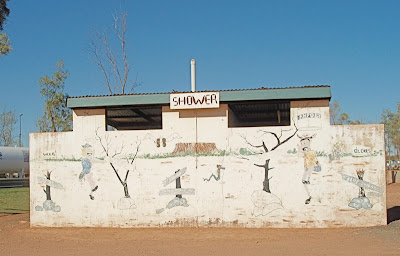October 28
More flat red earth, dotted with desert oaks and spinifex to drive through. Every kilometre was different and every one was worth stopping to admire. The colours were dazzling.

We paid our entry into the National Park, booked into the one and only caravan park and set off to see the Olgas, now more often called Kata Tjuta. These massive chunks are conglomerate, unlike Uluru which is a particular form of ancient granite called arkose. We stopped first at a viewing area looking across towards the jumble of rocks, through groves of desert oaks. Except for these designated viewing spots, there's no opportunity to pull off the road and there are signs specifically forbidding this just in case you might try.

I liked the way that the grid to protect the dunes you cross on foot was painted to match the landscape.

And the pattern made by wind pushing sand up against the grid.

A crested pigeon eyed me hopefully as I took the obligatory photos.

Further on, we followed a short track that led into one of the gorges between the rocks.


There was still a trickle of water across the track at one point in spite of months of drought.

The curves of the rock are so voluptuous, we were not surprised to read that this was a place in aboriginal lore for "secret men's business"

Returning the 40 or so kms to Uluru, we followed the road around its base. Photos cannot capture how vast this monolith is as it towers above the plain. Naturally that doesn't stop any of us, including me, from taking our own snapshots, which look like everyone's else's snapshots, and not as good as those of the professionals.

If this was a Facebook page rather than a blog I would here insert a picture of me jumping in the air in front of Uluru. Instead I focused on some birds (kingfishers?) near a waterhole,

a lone climber (most people respect the traditional owners' request that you not climb the rock),

and some of the curves and folds in the huge monolith.


The moon and a cork tree against the flank of the rock also appealed to me.

Along with many others we returned at dusk to watch the changing colour as the sun went down.












































